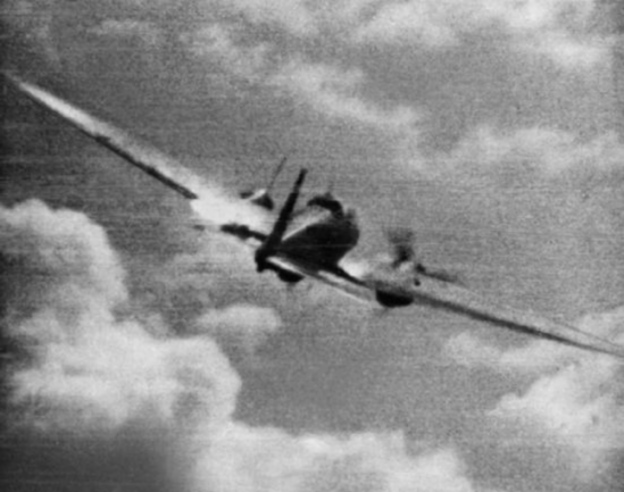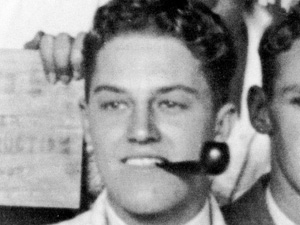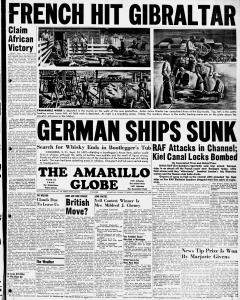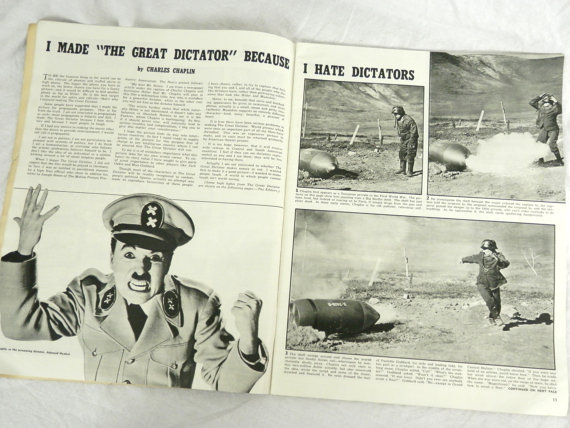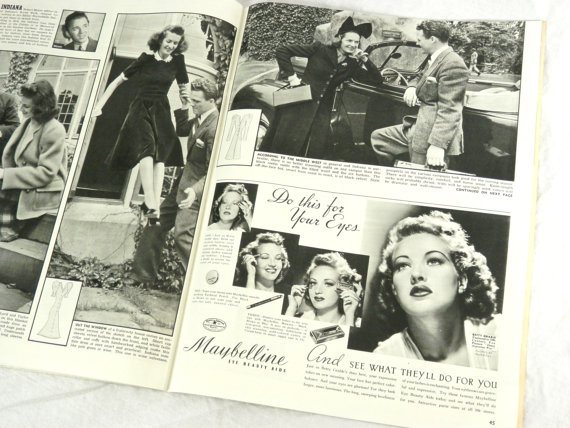Wednesday 25 September 1940
 |
| A dogfight over England. "This camera gun film still shows tracer ammunition from an RAF Supermarine Spitfire Mark I, flown by Flight Lieutenant J H G McArthur, hitting a German Heinkel He 111. These aircraft were part of a large formation which attacked the Bristol Aeroplane Company's works at Filton, Bristol, just before noon on 25 September 1940." © IWM (CH 1823). |
Operation Menace: With the British/Free French invasion frustrated, the French turn to the attack on 25 September 1940. The Vichy French Air Force (Armée de l'Air de Vichy), based in Morocco and Algeria, launches another, larger strike on Gibraltar than on the 24th. This is in retaliation for the Operation Menace attack on Dakar by the British and Free French. It is even larger than the attack on 24 September, this time including 80-100 aircraft dropping some 300 bombs. This is the largest air raid of the war to date on Gibraltar, causing extensive damage to the dockyard facilities. British 550 ton anti-submarine trawler HMT Stella Sirius is sunk by direct hits in the harbor with 12 deaths. Some accounts state that four Vichy French destroyers also bombard the port.
The British fleet again bombards Dakar at first light. French submarine Bévéziers, the only one remaining at Dakar after two have been sunk, manages at 09:00 to evade detection by the assembled fleet and torpedoes British battleship HMS Resolution. It loses power and must be towed back to Freetown, Sierra Leone, by HMS Barham, which also takes damage from the French battleship Richelieu. This forces the Royal Navy to end the operation, which has been accomplishing nothing anyway.
The affair has been a fiasco for the Allies. Long in the planning, involving extensive Royal Navy movements throughout September, Operation Menace accomplishes nothing but further poison relations with the Vichy French. General Charles de Gaulle suffers a huge loss in prestige, as his assumption of the mantle of resistance to his former French bosses turns out to have less appeal than he has claimed. It is easier now to portray de Gaulle as nothing but a tool of British interests. The Royal Navy itself does not come off well, either.
In a wider sense, Operation Menace is a learning experience. It is the first in a series of Allied raids along the length of the Atlantic Coast that will grow in intensity over the coming years. While a shaky start, it sets the foundation for later efforts at Dieppe, in Norway, and ultimately at Normandy. However, there is no question whatsoever that, in the short run, this is a major Vichy French victory.
Battle of the Atlantic: A Coastal Command flying boat flying over the shipping lanes in the mid-Atlantic spots a lifeboat and vectors in destroyer HMS Anthony. It turns out to be from the City of Benares, sunk on the 18th. Lifeboat 12 contains about 40 survivors, including six boys from the Children's Overseas Reception Board (CORB) program. Also on board are Mary Cornish and Father Rory O'Sullivan, the children's escorts, along with numerous crewmen.
U-32 (Oblt.z.S. Hans Jenisch) torpedoes and sinks 6694-ton British freighter Mabriton 500 hundred miles west of Ireland at 03:25. There are 25 survivors and 12 crew perish. The Mabriton was sailing with Convoy OB 216, which had dispersed.
U-43 (Kptlt. Wilhelm Ambrosius) torpedoes and sinks 5802-ton British freighter Sulairia about 400 miles out in the Atlantic west of Ireland around 13:30. There are 56 survivors and one fatality. The Sulairia was sailing with Convoy OB 217, which had dispersed.
U-29 (Kptlt. Otto Schuhart) torpedoes and damages 6223-ton British freighter/passenger ship Eurymedon (John Faulkner Webster) west of Ireland around 14:00. The ship stays afloat for two days before sinking. There are 66 survivors (42 crew and 22 passengers) and 29 perish (9 passengers and 20 crew). Captain Faulkner, who survives, later receives the Lloyd's War Medal for bravery at sea. The Eurymedon was part of Convoy OB 217, which had dispersed.
Italian 569 ton cargo ship Rina Croce hits a mine and sinks about 6 nautical miles west of Capo di Torre Cavallo (near Brindisi). The HMS Rorqual laid the minefield on 14 June 1940.
British 79 ton naval trawler HMT White Daisy founders in the North Sea near Lerwick.
The Royal Navy seizes Vichy French 1344 ton ocean-going trawler Finland near the Vichy French base at Saint Pierre and Miquelon, Canada. They transfer it to de Gaulle's Free French movement.
The Royal Canadian Navy AMC Prince Robert captures 9170-ton German freighter Weser off Manzanillo, Mexico just before midnight. The Weser is a supply ship for German raider Orion. The Canadians, approaching in the dark, get aboard before the crew can scuttle the freighter. The Canadians put aboard a prize crew who sail it to Esquimalt, where it is renamed Vancouver Island.
The British prepare Operation Lucid, which is designed to use obsolete warships as fire ships against the invasion barges in Channel ports. The operation is set for the 26th. It is a throwback to the use of fireships against the Spanish Armada and during the Napoleonic Wars. Escorted by destroyer forces, the fire ships are old tankers Nizam and Nawab. The tankers are packed with various flammables including heavy fuel oil, gasoline, and diesel oil. The force leaves port today (Sheerness and Portsmouth) - the old fire ships are very slow. En route, the Nizam breaks down less than 10 miles from Boulogne Harbor and the operation is canceled.
Royal Navy submarine Cachalot fires torpedoes and U-138 in the Bay of Biscay but misses. The British submarines like to lie in wait on the typical routes taken by U-boats from their main bases to and from their Atlantic patrol stations.
British minelayers Plover and Willem van der Zaan run aground on the Goodwins but are brought off by a tug. They are prevented from laying their mines.
Convoy FS 290 departs from the Tyne, Convoy FN 291 departs from Methil, Convoy OB 219 departs from Liverpool, Convoy SLS 49 departs from Freetown.
Battle of the Mediterranean: On the desert front, the RAF attacks Tobruk, while the Royal Navy shells Sidi Barrani. The RAF raids Berbera in British Somaliland and the port of Assab in Ethiopia.
A Royal Navy destroyer flotilla operating out of Alexandria bombards an Italian land convoy west of Sidi Barrani, causing extensive damage to the vehicles.
At Malta, there is an air raid around noontime which drops some bombs on the countryside. The Italians lose one Macchi C. 200 Saetta ("Arrow") fighter. The soldiers at Malta already are occupied defusing unexploded bombs at Hal Far and Luqa airfields which have been dropped over the previous two weeks.
Reichsmarschall Hermann Goering continues fine-tuning his aerial assault on England. This time, he cuts back on raids against London and shifts his focus toward British aircraft factories. These are primarily located in the western half of Britain, and Luftlotte 3 (Sperrle) is given primary responsibility. While perhaps justified by changing priorities, these types of changes are demoralizing to Luftwaffe crews who see no lasting results from all their efforts. These changes do, however, catch the RAF off guard now and then, and this happens today, to England's detriment.
Losses for the day are usually given as 13 for the Luftwaffe and 4 for the RAF. These figures, however, do not include the numerous brand new RAF fighters destroyed on the ground at Filton. Once those are factored in, it is a roughly even day.
European Air Operations: RAF Bomber Command attacks Berlin again. It targets Tempelhof Airport, a munitions factory, power stations, and the railway. Other raids are launched on Kiel, warehouses at Osnabruck, Ehrang, Hamm, Mannheim and Hanover, and invasion ports including Flushing and Antwerp. Coastal Command chips in with a raid on Brest, which sets the oil tanks there alight.
Spy Stuff: The US Signals Intelligence Service has been hard at work on breaking the Japanese military codes. Today, it reads the Japanese Purple Code for the first time.
German/Soviet/Japanese Relations: German Foreign Minister Ribbentrop informs the German embassy in Moscow that Japan is joining the German-Italian alliance (Axis). He emphasizes that this is not directed against the Soviet Union - which is absolutely true. Germany has other plans for the USSR. Ribbentrop instructs the Chargé d'affaires to tell Soviet Foreign Minister Molotov about the coming agreement on the 26th and explain that the alliance is directed against "American warmongers."
German/Spanish Relations: Adolf Hitler meets with Spanish Interior Minister - and Franco's brother-in-law - Serrano Suner. It is likely that the topics discussed include arranging a meeting between Hitler and Franco. Hitler's objective is to bring Spain into the war on his side in order to capture the British naval base at Gibraltar, while Franco demands an exorbitant price for his cooperation.
US/Chinese Relations: The US grants a $25 million loan to China that is designed to help stabilize the Chinese currency.
US Military: Heavy cruiser USS Louisville departs from Colon in the Panama Canal Zone on another "Show the Flag" tour. Its first stop will be Recife, Brazil.
The Greenslade Board investigating new US bases acquired from the British in the destroyers-for-bases deal arrives in Norfolk, Virginia.
Norway: Pursuant to decisions taken earlier, the German Reich-Commissar for Norway (Reichskommissar für die besetzten Norwegischen Gebiete), Josef Terboven, dissolves all political parties except for the pro-German Nasjonal Samling. He appoints 13 commissars to govern the country. As the leader of Nasjonal Samling, Vidkun Quisling forms the new collaborationist government. In addition, the King and his former government are formally deposed.
French Indochina: The Japanese invasion of French Indochina continues. The Japanese have aircraft carriers off the coast in the Gulf of Tonkin that are launching raids on French bases. The French shore batteries remain under orders to repel any invasion. The French have sent a special envoy to Tokyo to negotiate. The Japanese are primarily interested in northern Indochina in the Haiphong area, not as much in the area further south by Saigon. The Japanese 5th Infantry Division consolidates its hold on Lang Son, site of a key airfield.
New Caledonia: The government of Noumea reaffirms that it is siding with Free France.
American Homefront: Eleanor Roosevelt attends the American Newspaper Guild meeting in New York City (of which she is a member, with voting privileges). At issue is whether to approve a report critical of President Roosevelt as trying to force the United States into the European War. She votes against the report, but it passes 140-85. Afterward, she meets with the Guild's leaders and expresses her disagreement. The incident is an early foray by Mrs. Roosevelt into politics and an indication of the widespread isolationist sentiment in the country.
September 1940
September 1, 1940: RAF's Horrible Weekend
September 2, 1940: German Troopship Sunk
September 3, 1940: Destroyers for Bases
September 4, 1940: Enter Antonescu
September 5, 1940: Stukas Over Malta
September 6, 1940: The Luftwaffe Peaks
September 7, 1940: The Blitz Begins
September 8, 1940: Codeword Cromwell
September 9, 1940: Italians Attack Egypt
September 10, 1940: Hitler Postpones Sealion
September 11, 1940: British Confusion at Gibraltar
September 12, 1940: Warsaw Ghetto Approved
September 13, 1940: Zeros Attack!
September 14, 1940: The Draft Is Back
September 15, 1940: Battle of Britain Day
September 16, 1940: italians Take Sidi Barrani
September 17, 1940: Sealion Kaputt
September 18, 1940: City of Benares Incident
September 19, 1940: Disperse the Barges
September 20, 1940: A Wolfpack Gathers
September 21, 1940: Wolfpack Strikes Convoy HX-72
September 22, 1940: Vietnam War Begins
September 23, 1940: Operation Menace Begins
September 24, 1940: Dakar Fights Back
September 25, 1940: Filton Raid
September 26, 1940: Axis Time
September 27, 1940: Graveney Marsh Battle
September 28, 1940: Radio Belgique Begins
September 29, 1940: Brocklesby Collision
September 30, 1940: Operation Lena
2020
The British fleet again bombards Dakar at first light. French submarine Bévéziers, the only one remaining at Dakar after two have been sunk, manages at 09:00 to evade detection by the assembled fleet and torpedoes British battleship HMS Resolution. It loses power and must be towed back to Freetown, Sierra Leone, by HMS Barham, which also takes damage from the French battleship Richelieu. This forces the Royal Navy to end the operation, which has been accomplishing nothing anyway.
The affair has been a fiasco for the Allies. Long in the planning, involving extensive Royal Navy movements throughout September, Operation Menace accomplishes nothing but further poison relations with the Vichy French. General Charles de Gaulle suffers a huge loss in prestige, as his assumption of the mantle of resistance to his former French bosses turns out to have less appeal than he has claimed. It is easier now to portray de Gaulle as nothing but a tool of British interests. The Royal Navy itself does not come off well, either.
In a wider sense, Operation Menace is a learning experience. It is the first in a series of Allied raids along the length of the Atlantic Coast that will grow in intensity over the coming years. While a shaky start, it sets the foundation for later efforts at Dieppe, in Norway, and ultimately at Normandy. However, there is no question whatsoever that, in the short run, this is a major Vichy French victory.
 |
| U-48, with commander Heinrich Bleichrodt, returns to base at Lorient. 25 September 1940. Note the numerous victory pennants. |
U-32 (Oblt.z.S. Hans Jenisch) torpedoes and sinks 6694-ton British freighter Mabriton 500 hundred miles west of Ireland at 03:25. There are 25 survivors and 12 crew perish. The Mabriton was sailing with Convoy OB 216, which had dispersed.
U-43 (Kptlt. Wilhelm Ambrosius) torpedoes and sinks 5802-ton British freighter Sulairia about 400 miles out in the Atlantic west of Ireland around 13:30. There are 56 survivors and one fatality. The Sulairia was sailing with Convoy OB 217, which had dispersed.
U-29 (Kptlt. Otto Schuhart) torpedoes and damages 6223-ton British freighter/passenger ship Eurymedon (John Faulkner Webster) west of Ireland around 14:00. The ship stays afloat for two days before sinking. There are 66 survivors (42 crew and 22 passengers) and 29 perish (9 passengers and 20 crew). Captain Faulkner, who survives, later receives the Lloyd's War Medal for bravery at sea. The Eurymedon was part of Convoy OB 217, which had dispersed.
Italian 569 ton cargo ship Rina Croce hits a mine and sinks about 6 nautical miles west of Capo di Torre Cavallo (near Brindisi). The HMS Rorqual laid the minefield on 14 June 1940.
British 79 ton naval trawler HMT White Daisy founders in the North Sea near Lerwick.
The Royal Navy seizes Vichy French 1344 ton ocean-going trawler Finland near the Vichy French base at Saint Pierre and Miquelon, Canada. They transfer it to de Gaulle's Free French movement.
The Royal Canadian Navy AMC Prince Robert captures 9170-ton German freighter Weser off Manzanillo, Mexico just before midnight. The Weser is a supply ship for German raider Orion. The Canadians, approaching in the dark, get aboard before the crew can scuttle the freighter. The Canadians put aboard a prize crew who sail it to Esquimalt, where it is renamed Vancouver Island.
The British prepare Operation Lucid, which is designed to use obsolete warships as fire ships against the invasion barges in Channel ports. The operation is set for the 26th. It is a throwback to the use of fireships against the Spanish Armada and during the Napoleonic Wars. Escorted by destroyer forces, the fire ships are old tankers Nizam and Nawab. The tankers are packed with various flammables including heavy fuel oil, gasoline, and diesel oil. The force leaves port today (Sheerness and Portsmouth) - the old fire ships are very slow. En route, the Nizam breaks down less than 10 miles from Boulogne Harbor and the operation is canceled.
Royal Navy submarine Cachalot fires torpedoes and U-138 in the Bay of Biscay but misses. The British submarines like to lie in wait on the typical routes taken by U-boats from their main bases to and from their Atlantic patrol stations.
British minelayers Plover and Willem van der Zaan run aground on the Goodwins but are brought off by a tug. They are prevented from laying their mines.
Convoy FS 290 departs from the Tyne, Convoy FN 291 departs from Methil, Convoy OB 219 departs from Liverpool, Convoy SLS 49 departs from Freetown.
 |
| German freighter Weser is captured on 25 September 1940. |
A Royal Navy destroyer flotilla operating out of Alexandria bombards an Italian land convoy west of Sidi Barrani, causing extensive damage to the vehicles.
At Malta, there is an air raid around noontime which drops some bombs on the countryside. The Italians lose one Macchi C. 200 Saetta ("Arrow") fighter. The soldiers at Malta already are occupied defusing unexploded bombs at Hal Far and Luqa airfields which have been dropped over the previous two weeks.
Reichsmarschall Hermann Goering continues fine-tuning his aerial assault on England. This time, he cuts back on raids against London and shifts his focus toward British aircraft factories. These are primarily located in the western half of Britain, and Luftlotte 3 (Sperrle) is given primary responsibility. While perhaps justified by changing priorities, these types of changes are demoralizing to Luftwaffe crews who see no lasting results from all their efforts. These changes do, however, catch the RAF off guard now and then, and this happens today, to England's detriment.
The weather is good, but nothing much happens until about noontime. Then, a large raid targets the Bristol Aeroplane Company at Filton, a favorite target of the Luftwaffe which it has attacked over and over. About 80 bombers of KG 55 cross at Weymouth and bomb the factory and also oil installations at Portland. Fighter Command vectors its fighters to an expected target that turns out to be wrong, and thus the defending fighters get a late start on the Heinkel He 111s escorted by 52 Bf 110s of ZG 26.
The bombers reach their targets without much interference aside from anti-aircraft fire, even if the ride home is hot. RAF Nos. 152, 229, 234 and 238 Squadrons defend and bring down eight bombers, most on the way back to France. Canadian pilot John Urwin-Mann gets two of the planes. The raid causes extensive damage, including to shelters hit by bombs that kill and injure many inside. The Luftwaffe also destroys 8 fighters on the ground, including two Beaufighter night-fighters. There are 132 deaths, 91 of them factory workers, and 315 other casualties. It is a major Luftwaffe victory.
The Germans are fully aware of their success after reconnaissance flights confirm it, and KG 55 Gruppenkommandeur Major Friedrich Kless later is awarded the Ritterkreuz for it. The British are alarmed and shifts RAF No. 504 Squadron from Hendon to Filton to guard against future attacks.
The next big raid is at 16:00, and it targets the Isle of Wight area. Fighter Command does a better job of intercepting this raid, shooting down a bomber at no cost, but the bombers drop their bombs at random and destroy a lot of homes and underground infrastructure.
Losses for the day are usually given as 13 for the Luftwaffe and 4 for the RAF. These figures, however, do not include the numerous brand new RAF fighters destroyed on the ground at Filton. Once those are factored in, it is a roughly even day.
The Tubes set an all-time record for people sheltering in them from the Blitz.
Feldwebel Walter Scherer of III,/ZG 26, with 7 victory claims, is shot down and he becomes a POW during the Filton raid.
Feldwebel Walter Scherer of III,/ZG 26, with 7 victory claims, is shot down and he becomes a POW during the Filton raid.
The Italians are fulfilling Mussolini's promise to participate in the Battle of Britain - even though it is virtually over. They are transferring 2 Gruppos to Melsbroek airbase in Belgium northeast of Brussels. The total projected Italian force:
- 36 CR 42 Falco ("Falcon") biplane fighters;
- 36 Fiat G.50 Freccia ("Arrow") fighters;
- 72 Fiat BR.20 Cicogna ("Stork") bombers;
- 5 Cant Z 1007 Alcione ("Kingfisher") bombers.
While it is a large number of planes, the Italian models are mid-1930s designs (or earlier) which set records during that decade, but now are deathtraps on the highly competitive Channel front. The bombers are slow, ponderous and poorly armed, while the fighters are completely outclassed by much faster Spitfires and Hurricanes.
 |
| Winston Churchill and wife, Clementine, onboard a naval auxiliary patrol vessel, tour the London docks. 25 September 1940. |
Spy Stuff: The US Signals Intelligence Service has been hard at work on breaking the Japanese military codes. Today, it reads the Japanese Purple Code for the first time.
German/Soviet/Japanese Relations: German Foreign Minister Ribbentrop informs the German embassy in Moscow that Japan is joining the German-Italian alliance (Axis). He emphasizes that this is not directed against the Soviet Union - which is absolutely true. Germany has other plans for the USSR. Ribbentrop instructs the Chargé d'affaires to tell Soviet Foreign Minister Molotov about the coming agreement on the 26th and explain that the alliance is directed against "American warmongers."
German/Spanish Relations: Adolf Hitler meets with Spanish Interior Minister - and Franco's brother-in-law - Serrano Suner. It is likely that the topics discussed include arranging a meeting between Hitler and Franco. Hitler's objective is to bring Spain into the war on his side in order to capture the British naval base at Gibraltar, while Franco demands an exorbitant price for his cooperation.
US/Chinese Relations: The US grants a $25 million loan to China that is designed to help stabilize the Chinese currency.
US Military: Heavy cruiser USS Louisville departs from Colon in the Panama Canal Zone on another "Show the Flag" tour. Its first stop will be Recife, Brazil.
The Greenslade Board investigating new US bases acquired from the British in the destroyers-for-bases deal arrives in Norfolk, Virginia.
Norway: Pursuant to decisions taken earlier, the German Reich-Commissar for Norway (Reichskommissar für die besetzten Norwegischen Gebiete), Josef Terboven, dissolves all political parties except for the pro-German Nasjonal Samling. He appoints 13 commissars to govern the country. As the leader of Nasjonal Samling, Vidkun Quisling forms the new collaborationist government. In addition, the King and his former government are formally deposed.
French Indochina: The Japanese invasion of French Indochina continues. The Japanese have aircraft carriers off the coast in the Gulf of Tonkin that are launching raids on French bases. The French shore batteries remain under orders to repel any invasion. The French have sent a special envoy to Tokyo to negotiate. The Japanese are primarily interested in northern Indochina in the Haiphong area, not as much in the area further south by Saigon. The Japanese 5th Infantry Division consolidates its hold on Lang Son, site of a key airfield.
New Caledonia: The government of Noumea reaffirms that it is siding with Free France.
American Homefront: Eleanor Roosevelt attends the American Newspaper Guild meeting in New York City (of which she is a member, with voting privileges). At issue is whether to approve a report critical of President Roosevelt as trying to force the United States into the European War. She votes against the report, but it passes 140-85. Afterward, she meets with the Guild's leaders and expresses her disagreement. The incident is an early foray by Mrs. Roosevelt into politics and an indication of the widespread isolationist sentiment in the country.
September 1940
September 1, 1940: RAF's Horrible Weekend
September 2, 1940: German Troopship Sunk
September 3, 1940: Destroyers for Bases
September 4, 1940: Enter Antonescu
September 5, 1940: Stukas Over Malta
September 6, 1940: The Luftwaffe Peaks
September 7, 1940: The Blitz Begins
September 8, 1940: Codeword Cromwell
September 9, 1940: Italians Attack Egypt
September 10, 1940: Hitler Postpones Sealion
September 11, 1940: British Confusion at Gibraltar
September 12, 1940: Warsaw Ghetto Approved
September 13, 1940: Zeros Attack!
September 14, 1940: The Draft Is Back
September 15, 1940: Battle of Britain Day
September 16, 1940: italians Take Sidi Barrani
September 17, 1940: Sealion Kaputt
September 18, 1940: City of Benares Incident
September 19, 1940: Disperse the Barges
September 20, 1940: A Wolfpack Gathers
September 21, 1940: Wolfpack Strikes Convoy HX-72
September 22, 1940: Vietnam War Begins
September 23, 1940: Operation Menace Begins
September 24, 1940: Dakar Fights Back
September 25, 1940: Filton Raid
September 26, 1940: Axis Time
September 27, 1940: Graveney Marsh Battle
September 28, 1940: Radio Belgique Begins
September 29, 1940: Brocklesby Collision
September 30, 1940: Operation Lena
2020

